Communication Barriers & Strategies: Individual Report - LSC Suffolk
VerifiedAdded on 2022/11/25
|9
|2328
|469
Report
AI Summary
This individual report explores the critical role of business communication in organizational success, focusing on 'Something for Everyone' (SFE), a clothing chain providing online services. It discusses general theories of organizational communication, including Weber's classic theory and Tompkins and Cheney’s organizational control theory, highlighting their impact on organizational structure and employee control. The report identifies various communication barriers such as linguistic, psychological, cultural, technological, and emotional factors that SFE faces. Furthermore, it outlines strategies to overcome these barriers, including reducing perception differences, active listening, ensuring emotional stability, and emphasizing completeness and clarity in communication. The report concludes by recommending the implementation of these strategies and the adoption of Weber's theory to enhance communication and achieve organizational goals, stressing the importance of effective communication for sustained growth and performance.
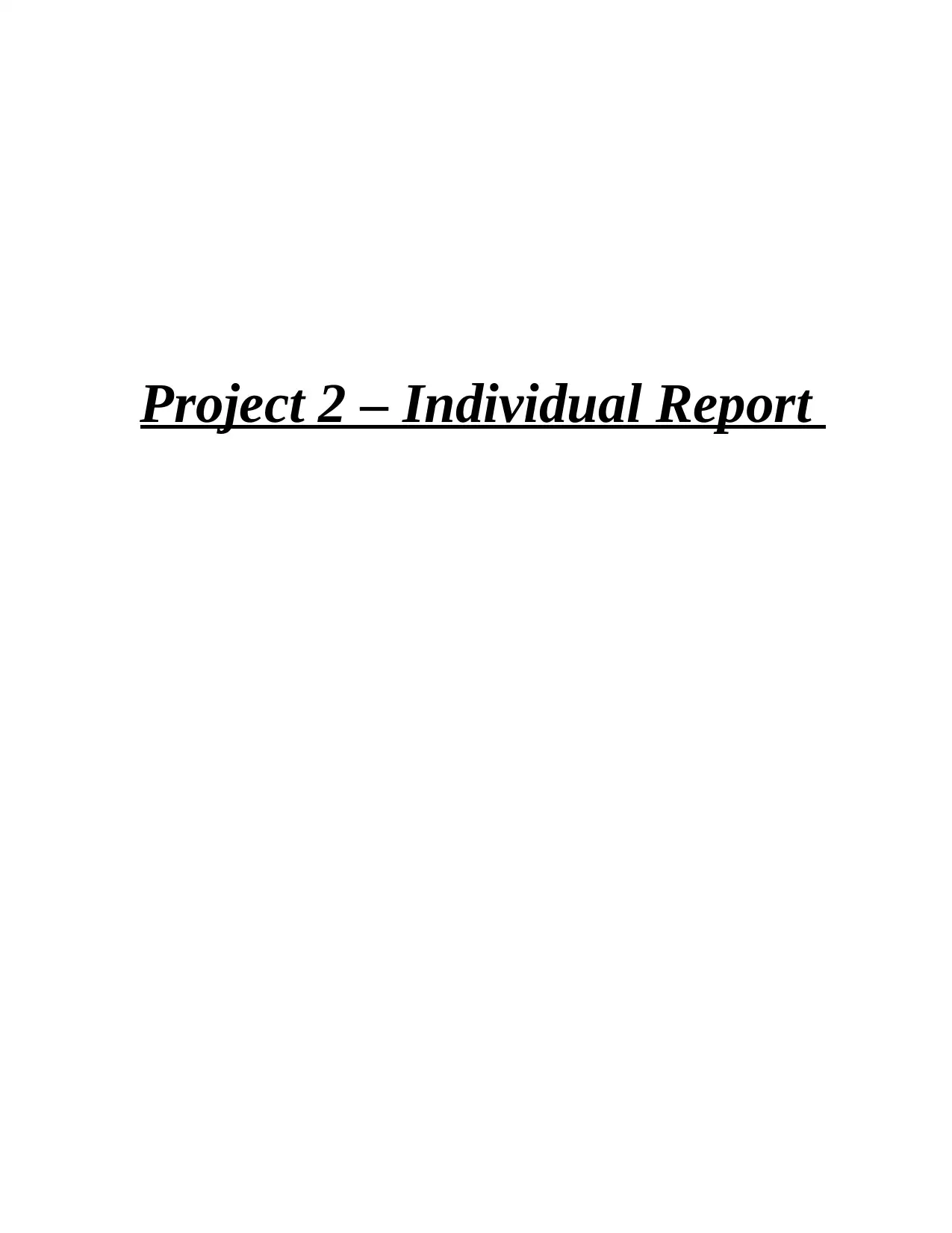
Project 2 – Individual Report
Paraphrase This Document
Need a fresh take? Get an instant paraphrase of this document with our AI Paraphraser
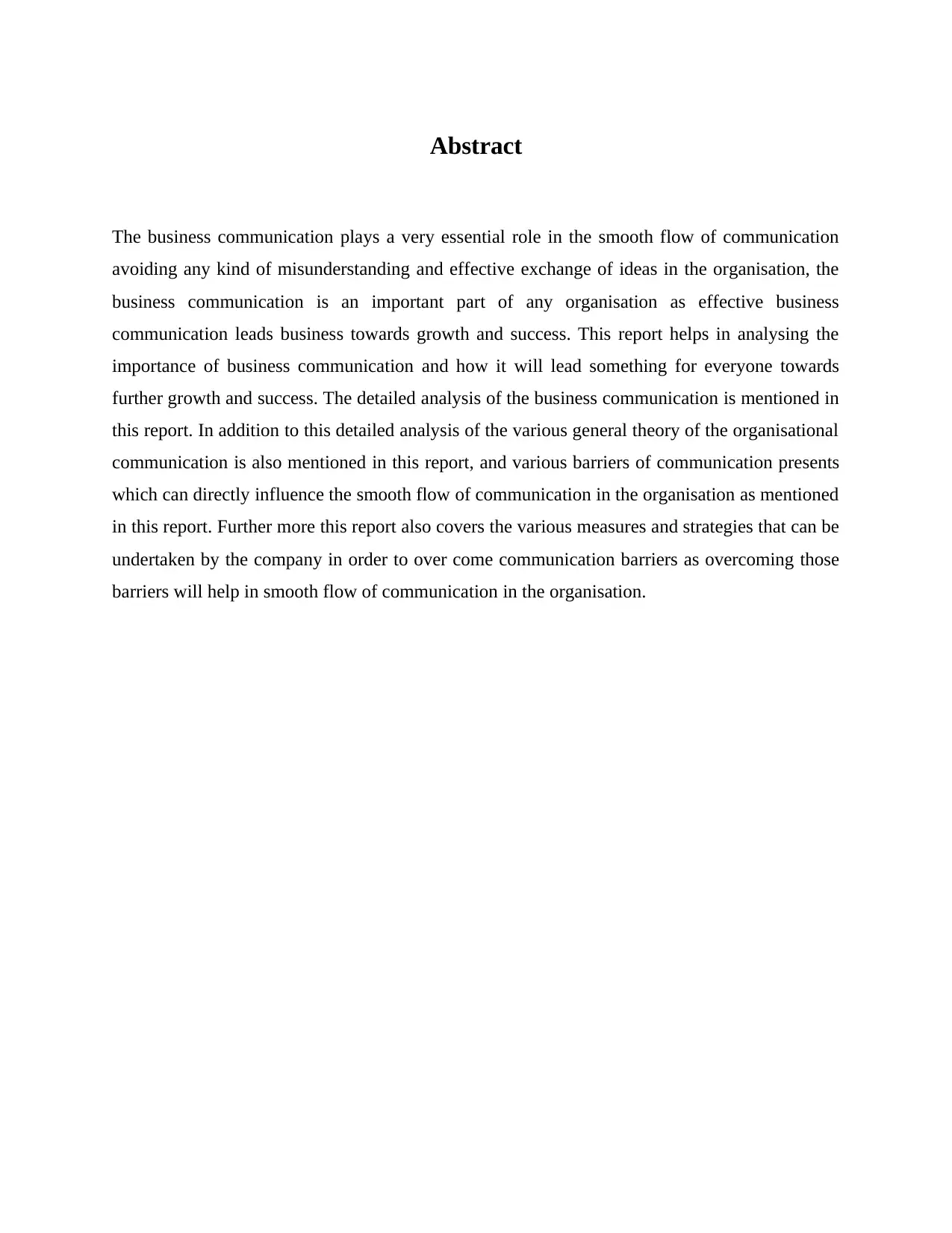
Abstract
The business communication plays a very essential role in the smooth flow of communication
avoiding any kind of misunderstanding and effective exchange of ideas in the organisation, the
business communication is an important part of any organisation as effective business
communication leads business towards growth and success. This report helps in analysing the
importance of business communication and how it will lead something for everyone towards
further growth and success. The detailed analysis of the business communication is mentioned in
this report. In addition to this detailed analysis of the various general theory of the organisational
communication is also mentioned in this report, and various barriers of communication presents
which can directly influence the smooth flow of communication in the organisation as mentioned
in this report. Further more this report also covers the various measures and strategies that can be
undertaken by the company in order to over come communication barriers as overcoming those
barriers will help in smooth flow of communication in the organisation.
The business communication plays a very essential role in the smooth flow of communication
avoiding any kind of misunderstanding and effective exchange of ideas in the organisation, the
business communication is an important part of any organisation as effective business
communication leads business towards growth and success. This report helps in analysing the
importance of business communication and how it will lead something for everyone towards
further growth and success. The detailed analysis of the business communication is mentioned in
this report. In addition to this detailed analysis of the various general theory of the organisational
communication is also mentioned in this report, and various barriers of communication presents
which can directly influence the smooth flow of communication in the organisation as mentioned
in this report. Further more this report also covers the various measures and strategies that can be
undertaken by the company in order to over come communication barriers as overcoming those
barriers will help in smooth flow of communication in the organisation.
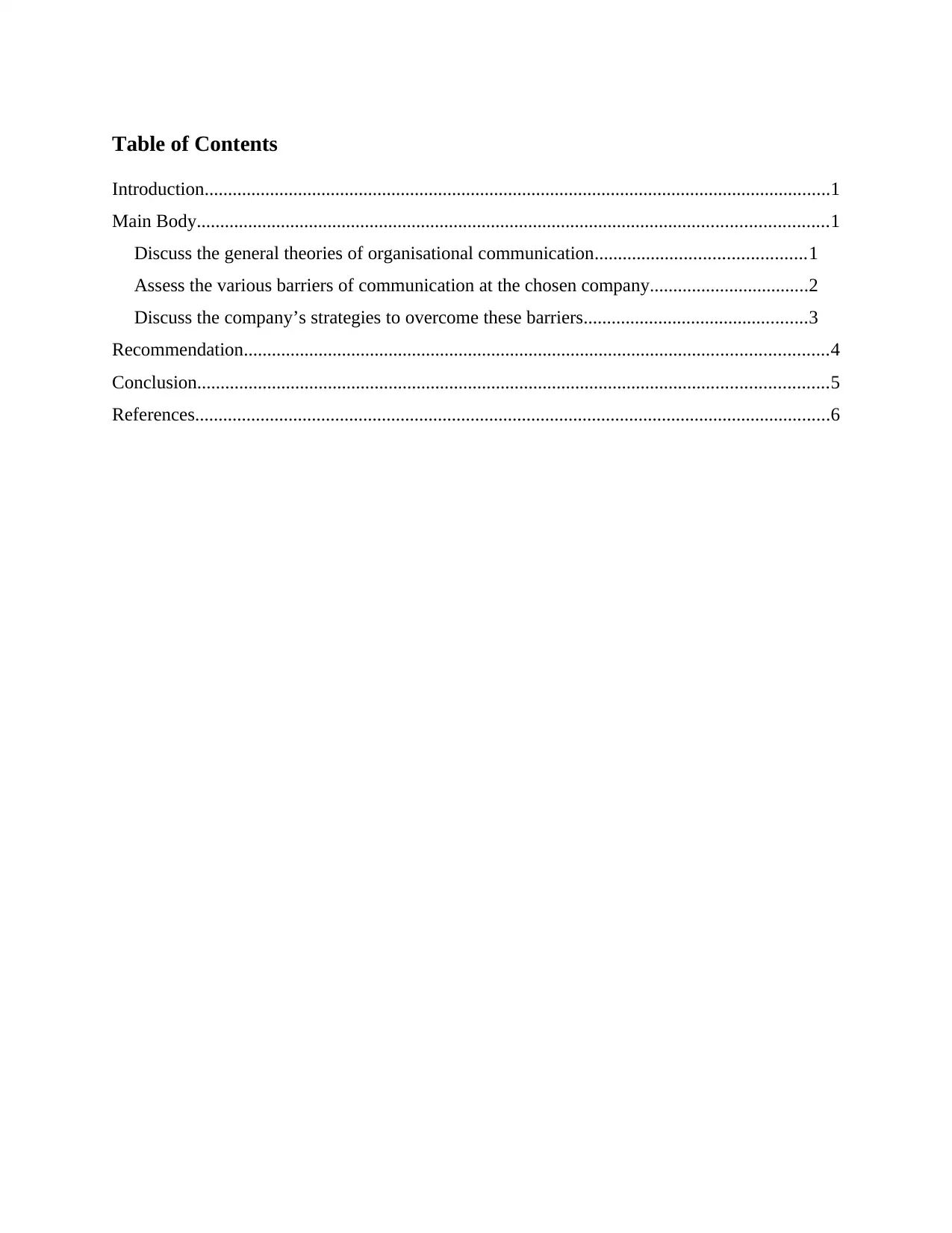
Table of Contents
Introduction......................................................................................................................................1
Main Body.......................................................................................................................................1
Discuss the general theories of organisational communication.............................................1
Assess the various barriers of communication at the chosen company..................................2
Discuss the company’s strategies to overcome these barriers................................................3
Recommendation.............................................................................................................................4
Conclusion.......................................................................................................................................5
References........................................................................................................................................6
Introduction......................................................................................................................................1
Main Body.......................................................................................................................................1
Discuss the general theories of organisational communication.............................................1
Assess the various barriers of communication at the chosen company..................................2
Discuss the company’s strategies to overcome these barriers................................................3
Recommendation.............................................................................................................................4
Conclusion.......................................................................................................................................5
References........................................................................................................................................6
⊘ This is a preview!⊘
Do you want full access?
Subscribe today to unlock all pages.

Trusted by 1+ million students worldwide
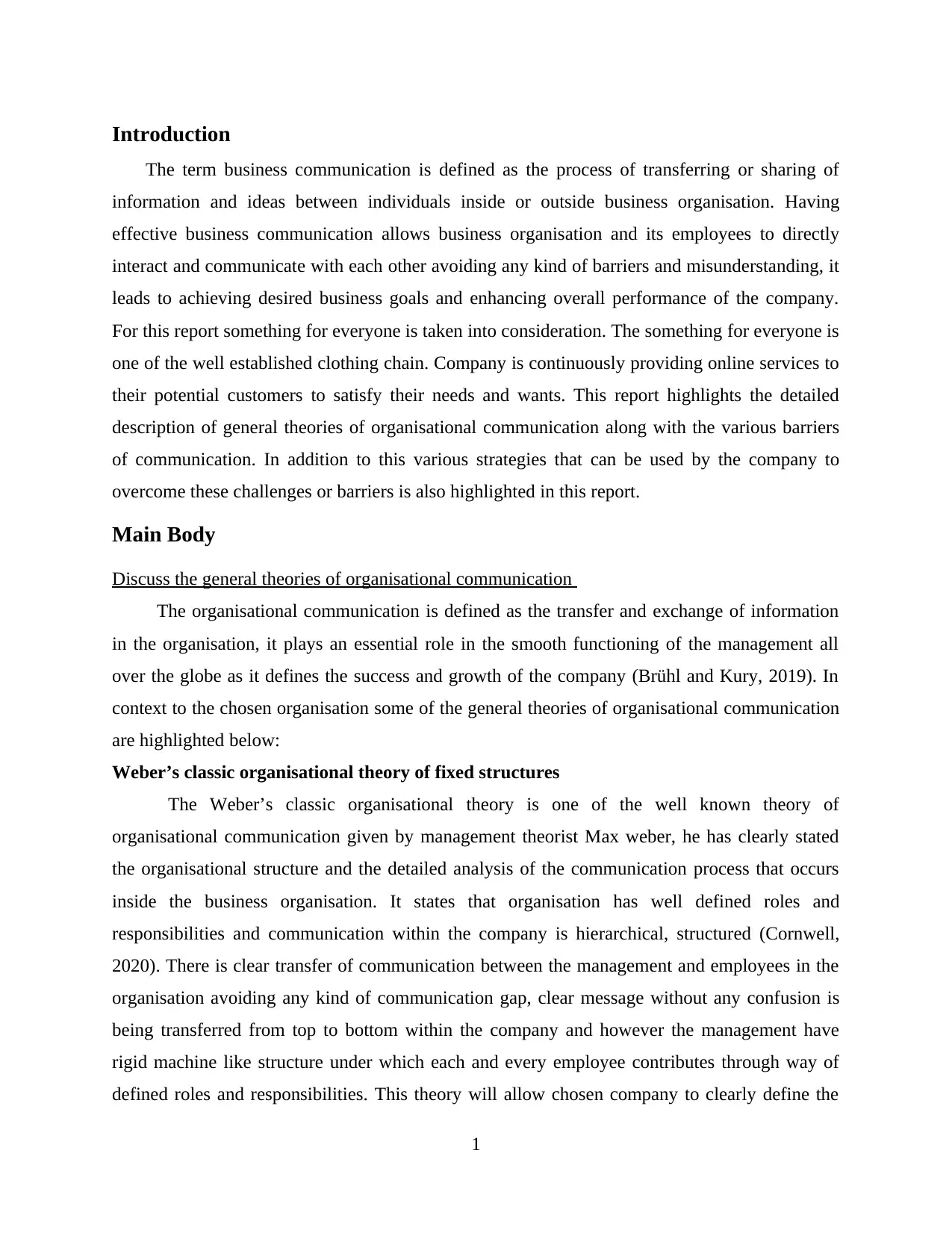
Introduction
The term business communication is defined as the process of transferring or sharing of
information and ideas between individuals inside or outside business organisation. Having
effective business communication allows business organisation and its employees to directly
interact and communicate with each other avoiding any kind of barriers and misunderstanding, it
leads to achieving desired business goals and enhancing overall performance of the company.
For this report something for everyone is taken into consideration. The something for everyone is
one of the well established clothing chain. Company is continuously providing online services to
their potential customers to satisfy their needs and wants. This report highlights the detailed
description of general theories of organisational communication along with the various barriers
of communication. In addition to this various strategies that can be used by the company to
overcome these challenges or barriers is also highlighted in this report.
Main Body
Discuss the general theories of organisational communication
The organisational communication is defined as the transfer and exchange of information
in the organisation, it plays an essential role in the smooth functioning of the management all
over the globe as it defines the success and growth of the company (Brühl and Kury, 2019). In
context to the chosen organisation some of the general theories of organisational communication
are highlighted below:
Weber’s classic organisational theory of fixed structures
The Weber’s classic organisational theory is one of the well known theory of
organisational communication given by management theorist Max weber, he has clearly stated
the organisational structure and the detailed analysis of the communication process that occurs
inside the business organisation. It states that organisation has well defined roles and
responsibilities and communication within the company is hierarchical, structured (Cornwell,
2020). There is clear transfer of communication between the management and employees in the
organisation avoiding any kind of communication gap, clear message without any confusion is
being transferred from top to bottom within the company and however the management have
rigid machine like structure under which each and every employee contributes through way of
defined roles and responsibilities. This theory will allow chosen company to clearly define the
1
The term business communication is defined as the process of transferring or sharing of
information and ideas between individuals inside or outside business organisation. Having
effective business communication allows business organisation and its employees to directly
interact and communicate with each other avoiding any kind of barriers and misunderstanding, it
leads to achieving desired business goals and enhancing overall performance of the company.
For this report something for everyone is taken into consideration. The something for everyone is
one of the well established clothing chain. Company is continuously providing online services to
their potential customers to satisfy their needs and wants. This report highlights the detailed
description of general theories of organisational communication along with the various barriers
of communication. In addition to this various strategies that can be used by the company to
overcome these challenges or barriers is also highlighted in this report.
Main Body
Discuss the general theories of organisational communication
The organisational communication is defined as the transfer and exchange of information
in the organisation, it plays an essential role in the smooth functioning of the management all
over the globe as it defines the success and growth of the company (Brühl and Kury, 2019). In
context to the chosen organisation some of the general theories of organisational communication
are highlighted below:
Weber’s classic organisational theory of fixed structures
The Weber’s classic organisational theory is one of the well known theory of
organisational communication given by management theorist Max weber, he has clearly stated
the organisational structure and the detailed analysis of the communication process that occurs
inside the business organisation. It states that organisation has well defined roles and
responsibilities and communication within the company is hierarchical, structured (Cornwell,
2020). There is clear transfer of communication between the management and employees in the
organisation avoiding any kind of communication gap, clear message without any confusion is
being transferred from top to bottom within the company and however the management have
rigid machine like structure under which each and every employee contributes through way of
defined roles and responsibilities. This theory will allow chosen company to clearly define the
1
Paraphrase This Document
Need a fresh take? Get an instant paraphrase of this document with our AI Paraphraser
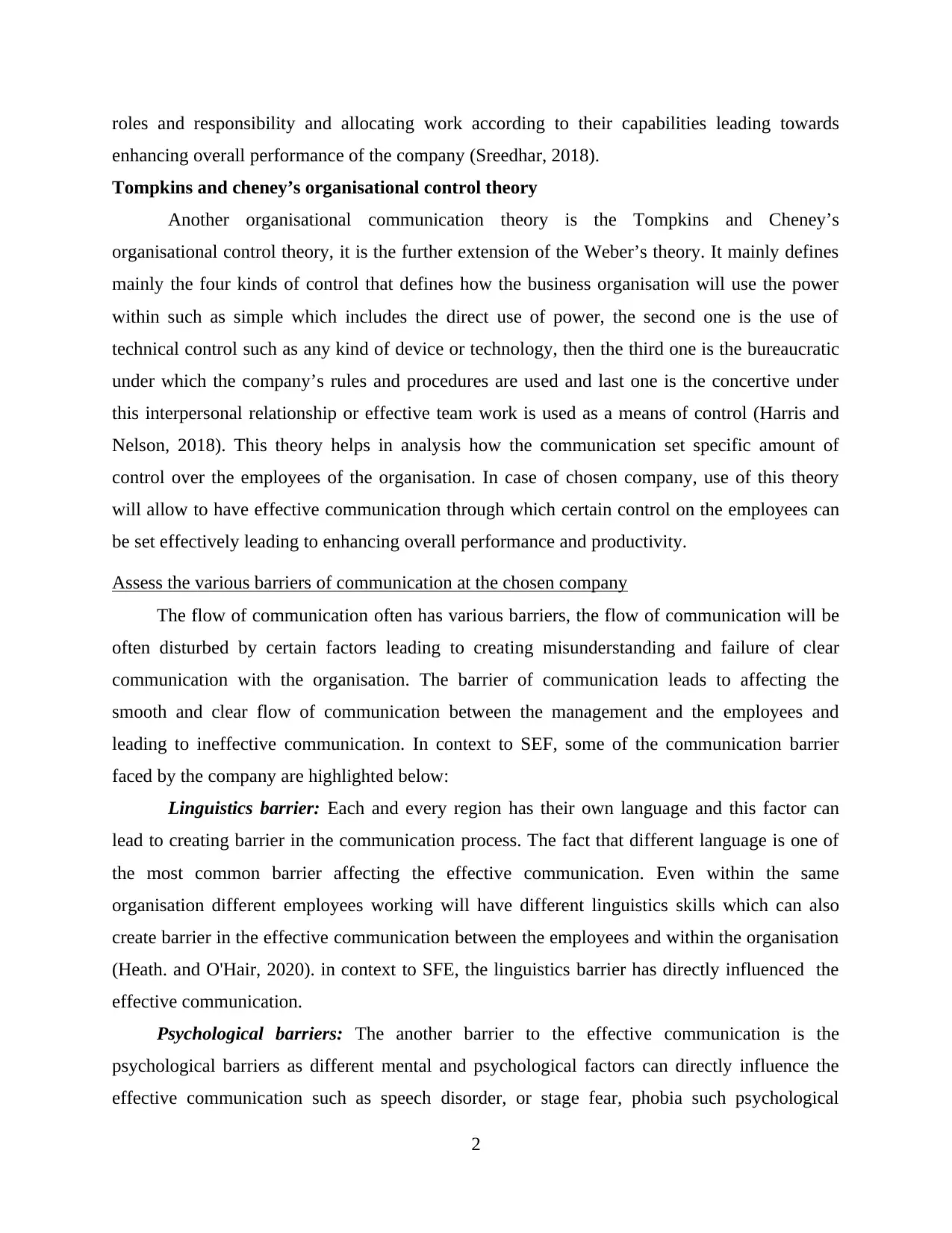
roles and responsibility and allocating work according to their capabilities leading towards
enhancing overall performance of the company (Sreedhar, 2018).
Tompkins and cheney’s organisational control theory
Another organisational communication theory is the Tompkins and Cheney’s
organisational control theory, it is the further extension of the Weber’s theory. It mainly defines
mainly the four kinds of control that defines how the business organisation will use the power
within such as simple which includes the direct use of power, the second one is the use of
technical control such as any kind of device or technology, then the third one is the bureaucratic
under which the company’s rules and procedures are used and last one is the concertive under
this interpersonal relationship or effective team work is used as a means of control (Harris and
Nelson, 2018). This theory helps in analysis how the communication set specific amount of
control over the employees of the organisation. In case of chosen company, use of this theory
will allow to have effective communication through which certain control on the employees can
be set effectively leading to enhancing overall performance and productivity.
Assess the various barriers of communication at the chosen company
The flow of communication often has various barriers, the flow of communication will be
often disturbed by certain factors leading to creating misunderstanding and failure of clear
communication with the organisation. The barrier of communication leads to affecting the
smooth and clear flow of communication between the management and the employees and
leading to ineffective communication. In context to SEF, some of the communication barrier
faced by the company are highlighted below:
Linguistics barrier: Each and every region has their own language and this factor can
lead to creating barrier in the communication process. The fact that different language is one of
the most common barrier affecting the effective communication. Even within the same
organisation different employees working will have different linguistics skills which can also
create barrier in the effective communication between the employees and within the organisation
(Heath. and O'Hair, 2020). in context to SFE, the linguistics barrier has directly influenced the
effective communication.
Psychological barriers: The another barrier to the effective communication is the
psychological barriers as different mental and psychological factors can directly influence the
effective communication such as speech disorder, or stage fear, phobia such psychological
2
enhancing overall performance of the company (Sreedhar, 2018).
Tompkins and cheney’s organisational control theory
Another organisational communication theory is the Tompkins and Cheney’s
organisational control theory, it is the further extension of the Weber’s theory. It mainly defines
mainly the four kinds of control that defines how the business organisation will use the power
within such as simple which includes the direct use of power, the second one is the use of
technical control such as any kind of device or technology, then the third one is the bureaucratic
under which the company’s rules and procedures are used and last one is the concertive under
this interpersonal relationship or effective team work is used as a means of control (Harris and
Nelson, 2018). This theory helps in analysis how the communication set specific amount of
control over the employees of the organisation. In case of chosen company, use of this theory
will allow to have effective communication through which certain control on the employees can
be set effectively leading to enhancing overall performance and productivity.
Assess the various barriers of communication at the chosen company
The flow of communication often has various barriers, the flow of communication will be
often disturbed by certain factors leading to creating misunderstanding and failure of clear
communication with the organisation. The barrier of communication leads to affecting the
smooth and clear flow of communication between the management and the employees and
leading to ineffective communication. In context to SEF, some of the communication barrier
faced by the company are highlighted below:
Linguistics barrier: Each and every region has their own language and this factor can
lead to creating barrier in the communication process. The fact that different language is one of
the most common barrier affecting the effective communication. Even within the same
organisation different employees working will have different linguistics skills which can also
create barrier in the effective communication between the employees and within the organisation
(Heath. and O'Hair, 2020). in context to SFE, the linguistics barrier has directly influenced the
effective communication.
Psychological barriers: The another barrier to the effective communication is the
psychological barriers as different mental and psychological factors can directly influence the
effective communication such as speech disorder, or stage fear, phobia such psychological
2
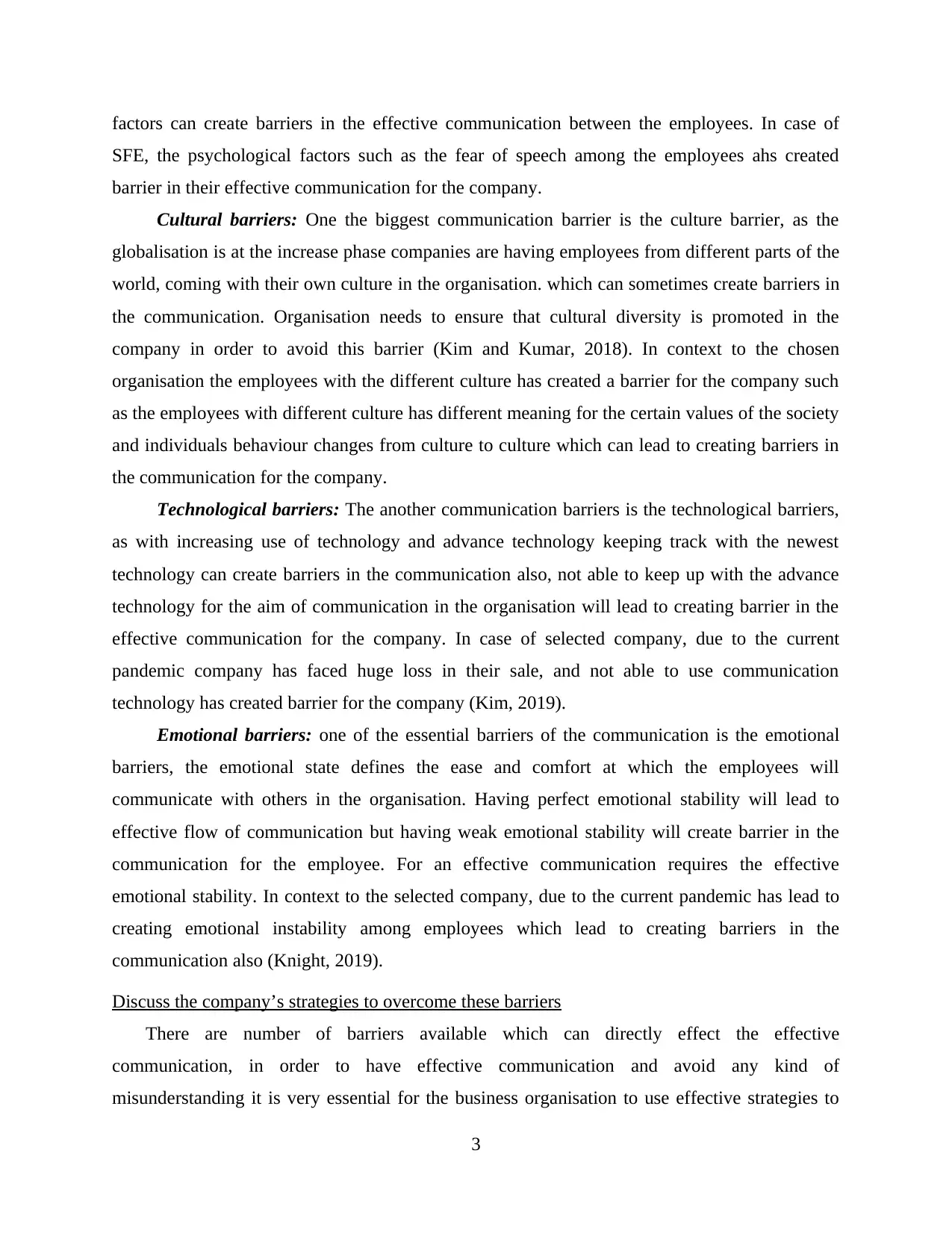
factors can create barriers in the effective communication between the employees. In case of
SFE, the psychological factors such as the fear of speech among the employees ahs created
barrier in their effective communication for the company.
Cultural barriers: One the biggest communication barrier is the culture barrier, as the
globalisation is at the increase phase companies are having employees from different parts of the
world, coming with their own culture in the organisation. which can sometimes create barriers in
the communication. Organisation needs to ensure that cultural diversity is promoted in the
company in order to avoid this barrier (Kim and Kumar, 2018). In context to the chosen
organisation the employees with the different culture has created a barrier for the company such
as the employees with different culture has different meaning for the certain values of the society
and individuals behaviour changes from culture to culture which can lead to creating barriers in
the communication for the company.
Technological barriers: The another communication barriers is the technological barriers,
as with increasing use of technology and advance technology keeping track with the newest
technology can create barriers in the communication also, not able to keep up with the advance
technology for the aim of communication in the organisation will lead to creating barrier in the
effective communication for the company. In case of selected company, due to the current
pandemic company has faced huge loss in their sale, and not able to use communication
technology has created barrier for the company (Kim, 2019).
Emotional barriers: one of the essential barriers of the communication is the emotional
barriers, the emotional state defines the ease and comfort at which the employees will
communicate with others in the organisation. Having perfect emotional stability will lead to
effective flow of communication but having weak emotional stability will create barrier in the
communication for the employee. For an effective communication requires the effective
emotional stability. In context to the selected company, due to the current pandemic has lead to
creating emotional instability among employees which lead to creating barriers in the
communication also (Knight, 2019).
Discuss the company’s strategies to overcome these barriers
There are number of barriers available which can directly effect the effective
communication, in order to have effective communication and avoid any kind of
misunderstanding it is very essential for the business organisation to use effective strategies to
3
SFE, the psychological factors such as the fear of speech among the employees ahs created
barrier in their effective communication for the company.
Cultural barriers: One the biggest communication barrier is the culture barrier, as the
globalisation is at the increase phase companies are having employees from different parts of the
world, coming with their own culture in the organisation. which can sometimes create barriers in
the communication. Organisation needs to ensure that cultural diversity is promoted in the
company in order to avoid this barrier (Kim and Kumar, 2018). In context to the chosen
organisation the employees with the different culture has created a barrier for the company such
as the employees with different culture has different meaning for the certain values of the society
and individuals behaviour changes from culture to culture which can lead to creating barriers in
the communication for the company.
Technological barriers: The another communication barriers is the technological barriers,
as with increasing use of technology and advance technology keeping track with the newest
technology can create barriers in the communication also, not able to keep up with the advance
technology for the aim of communication in the organisation will lead to creating barrier in the
effective communication for the company. In case of selected company, due to the current
pandemic company has faced huge loss in their sale, and not able to use communication
technology has created barrier for the company (Kim, 2019).
Emotional barriers: one of the essential barriers of the communication is the emotional
barriers, the emotional state defines the ease and comfort at which the employees will
communicate with others in the organisation. Having perfect emotional stability will lead to
effective flow of communication but having weak emotional stability will create barrier in the
communication for the employee. For an effective communication requires the effective
emotional stability. In context to the selected company, due to the current pandemic has lead to
creating emotional instability among employees which lead to creating barriers in the
communication also (Knight, 2019).
Discuss the company’s strategies to overcome these barriers
There are number of barriers available which can directly effect the effective
communication, in order to have effective communication and avoid any kind of
misunderstanding it is very essential for the business organisation to use effective strategies to
3
⊘ This is a preview!⊘
Do you want full access?
Subscribe today to unlock all pages.

Trusted by 1+ million students worldwide
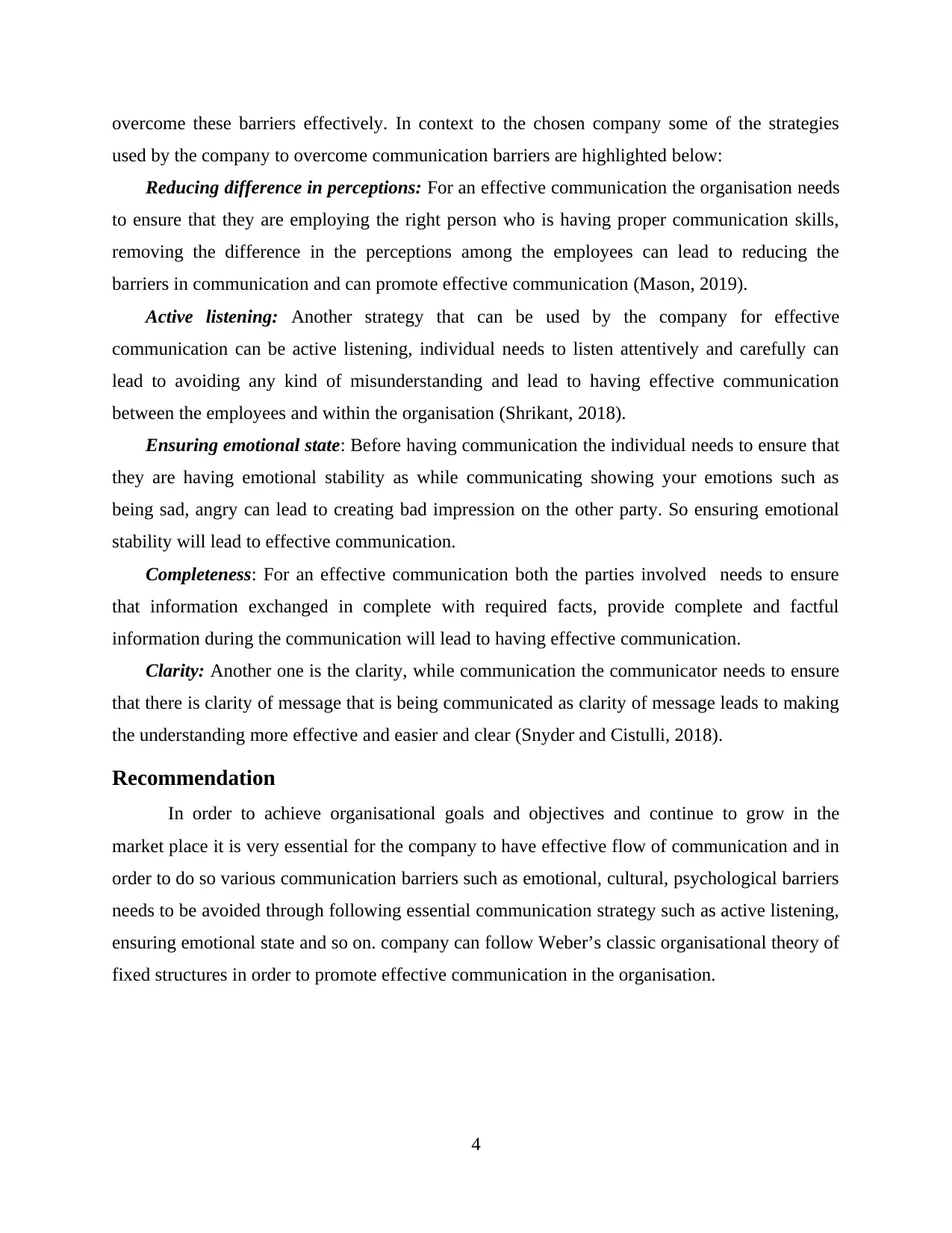
overcome these barriers effectively. In context to the chosen company some of the strategies
used by the company to overcome communication barriers are highlighted below:
Reducing difference in perceptions: For an effective communication the organisation needs
to ensure that they are employing the right person who is having proper communication skills,
removing the difference in the perceptions among the employees can lead to reducing the
barriers in communication and can promote effective communication (Mason, 2019).
Active listening: Another strategy that can be used by the company for effective
communication can be active listening, individual needs to listen attentively and carefully can
lead to avoiding any kind of misunderstanding and lead to having effective communication
between the employees and within the organisation (Shrikant, 2018).
Ensuring emotional state: Before having communication the individual needs to ensure that
they are having emotional stability as while communicating showing your emotions such as
being sad, angry can lead to creating bad impression on the other party. So ensuring emotional
stability will lead to effective communication.
Completeness: For an effective communication both the parties involved needs to ensure
that information exchanged in complete with required facts, provide complete and factful
information during the communication will lead to having effective communication.
Clarity: Another one is the clarity, while communication the communicator needs to ensure
that there is clarity of message that is being communicated as clarity of message leads to making
the understanding more effective and easier and clear (Snyder and Cistulli, 2018).
Recommendation
In order to achieve organisational goals and objectives and continue to grow in the
market place it is very essential for the company to have effective flow of communication and in
order to do so various communication barriers such as emotional, cultural, psychological barriers
needs to be avoided through following essential communication strategy such as active listening,
ensuring emotional state and so on. company can follow Weber’s classic organisational theory of
fixed structures in order to promote effective communication in the organisation.
4
used by the company to overcome communication barriers are highlighted below:
Reducing difference in perceptions: For an effective communication the organisation needs
to ensure that they are employing the right person who is having proper communication skills,
removing the difference in the perceptions among the employees can lead to reducing the
barriers in communication and can promote effective communication (Mason, 2019).
Active listening: Another strategy that can be used by the company for effective
communication can be active listening, individual needs to listen attentively and carefully can
lead to avoiding any kind of misunderstanding and lead to having effective communication
between the employees and within the organisation (Shrikant, 2018).
Ensuring emotional state: Before having communication the individual needs to ensure that
they are having emotional stability as while communicating showing your emotions such as
being sad, angry can lead to creating bad impression on the other party. So ensuring emotional
stability will lead to effective communication.
Completeness: For an effective communication both the parties involved needs to ensure
that information exchanged in complete with required facts, provide complete and factful
information during the communication will lead to having effective communication.
Clarity: Another one is the clarity, while communication the communicator needs to ensure
that there is clarity of message that is being communicated as clarity of message leads to making
the understanding more effective and easier and clear (Snyder and Cistulli, 2018).
Recommendation
In order to achieve organisational goals and objectives and continue to grow in the
market place it is very essential for the company to have effective flow of communication and in
order to do so various communication barriers such as emotional, cultural, psychological barriers
needs to be avoided through following essential communication strategy such as active listening,
ensuring emotional state and so on. company can follow Weber’s classic organisational theory of
fixed structures in order to promote effective communication in the organisation.
4
Paraphrase This Document
Need a fresh take? Get an instant paraphrase of this document with our AI Paraphraser
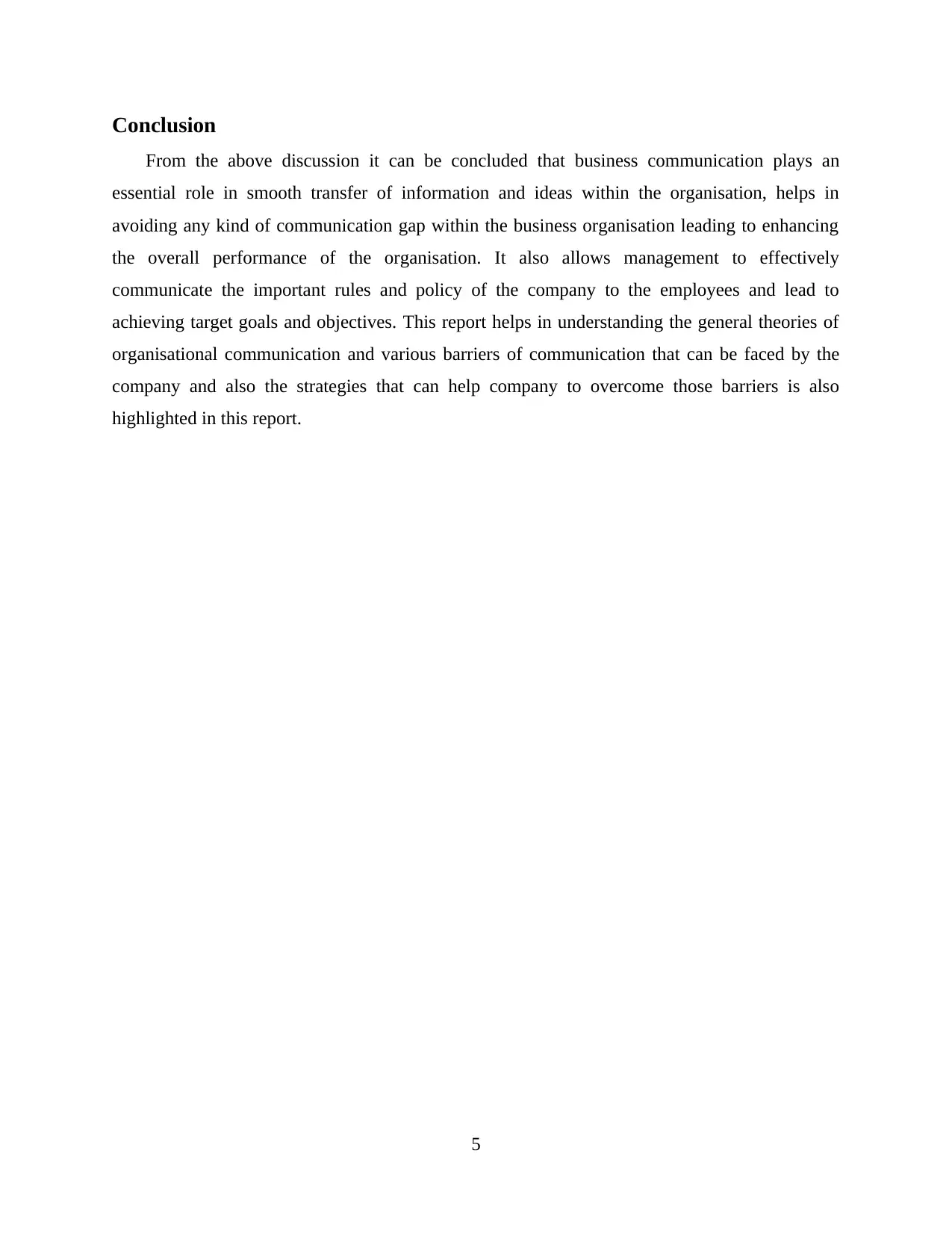
Conclusion
From the above discussion it can be concluded that business communication plays an
essential role in smooth transfer of information and ideas within the organisation, helps in
avoiding any kind of communication gap within the business organisation leading to enhancing
the overall performance of the organisation. It also allows management to effectively
communicate the important rules and policy of the company to the employees and lead to
achieving target goals and objectives. This report helps in understanding the general theories of
organisational communication and various barriers of communication that can be faced by the
company and also the strategies that can help company to overcome those barriers is also
highlighted in this report.
5
From the above discussion it can be concluded that business communication plays an
essential role in smooth transfer of information and ideas within the organisation, helps in
avoiding any kind of communication gap within the business organisation leading to enhancing
the overall performance of the organisation. It also allows management to effectively
communicate the important rules and policy of the company to the employees and lead to
achieving target goals and objectives. This report helps in understanding the general theories of
organisational communication and various barriers of communication that can be faced by the
company and also the strategies that can help company to overcome those barriers is also
highlighted in this report.
5
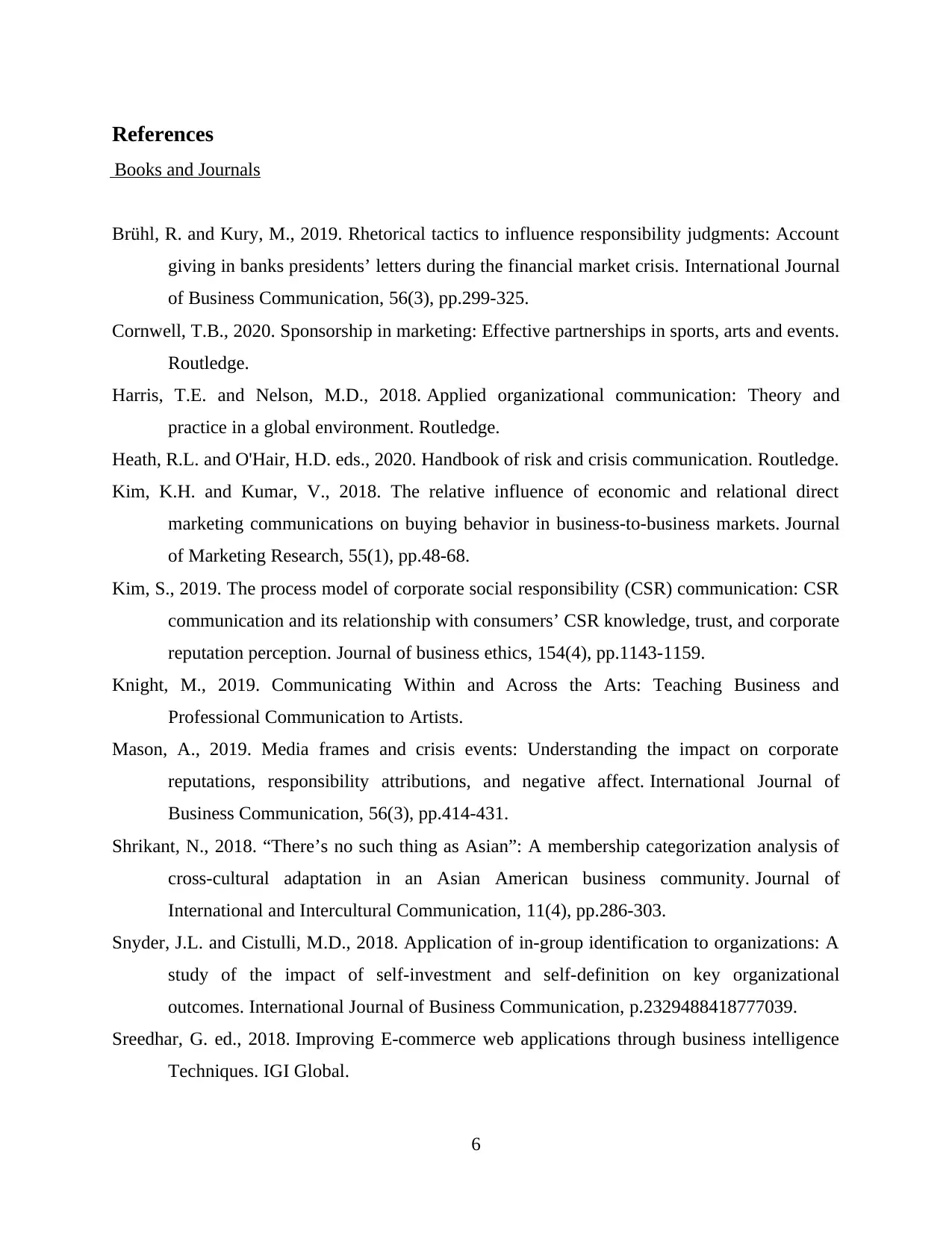
References
Books and Journals
Brühl, R. and Kury, M., 2019. Rhetorical tactics to influence responsibility judgments: Account
giving in banks presidents’ letters during the financial market crisis. International Journal
of Business Communication, 56(3), pp.299-325.
Cornwell, T.B., 2020. Sponsorship in marketing: Effective partnerships in sports, arts and events.
Routledge.
Harris, T.E. and Nelson, M.D., 2018. Applied organizational communication: Theory and
practice in a global environment. Routledge.
Heath, R.L. and O'Hair, H.D. eds., 2020. Handbook of risk and crisis communication. Routledge.
Kim, K.H. and Kumar, V., 2018. The relative influence of economic and relational direct
marketing communications on buying behavior in business-to-business markets. Journal
of Marketing Research, 55(1), pp.48-68.
Kim, S., 2019. The process model of corporate social responsibility (CSR) communication: CSR
communication and its relationship with consumers’ CSR knowledge, trust, and corporate
reputation perception. Journal of business ethics, 154(4), pp.1143-1159.
Knight, M., 2019. Communicating Within and Across the Arts: Teaching Business and
Professional Communication to Artists.
Mason, A., 2019. Media frames and crisis events: Understanding the impact on corporate
reputations, responsibility attributions, and negative affect. International Journal of
Business Communication, 56(3), pp.414-431.
Shrikant, N., 2018. “There’s no such thing as Asian”: A membership categorization analysis of
cross-cultural adaptation in an Asian American business community. Journal of
International and Intercultural Communication, 11(4), pp.286-303.
Snyder, J.L. and Cistulli, M.D., 2018. Application of in-group identification to organizations: A
study of the impact of self-investment and self-definition on key organizational
outcomes. International Journal of Business Communication, p.2329488418777039.
Sreedhar, G. ed., 2018. Improving E-commerce web applications through business intelligence
Techniques. IGI Global.
6
Books and Journals
Brühl, R. and Kury, M., 2019. Rhetorical tactics to influence responsibility judgments: Account
giving in banks presidents’ letters during the financial market crisis. International Journal
of Business Communication, 56(3), pp.299-325.
Cornwell, T.B., 2020. Sponsorship in marketing: Effective partnerships in sports, arts and events.
Routledge.
Harris, T.E. and Nelson, M.D., 2018. Applied organizational communication: Theory and
practice in a global environment. Routledge.
Heath, R.L. and O'Hair, H.D. eds., 2020. Handbook of risk and crisis communication. Routledge.
Kim, K.H. and Kumar, V., 2018. The relative influence of economic and relational direct
marketing communications on buying behavior in business-to-business markets. Journal
of Marketing Research, 55(1), pp.48-68.
Kim, S., 2019. The process model of corporate social responsibility (CSR) communication: CSR
communication and its relationship with consumers’ CSR knowledge, trust, and corporate
reputation perception. Journal of business ethics, 154(4), pp.1143-1159.
Knight, M., 2019. Communicating Within and Across the Arts: Teaching Business and
Professional Communication to Artists.
Mason, A., 2019. Media frames and crisis events: Understanding the impact on corporate
reputations, responsibility attributions, and negative affect. International Journal of
Business Communication, 56(3), pp.414-431.
Shrikant, N., 2018. “There’s no such thing as Asian”: A membership categorization analysis of
cross-cultural adaptation in an Asian American business community. Journal of
International and Intercultural Communication, 11(4), pp.286-303.
Snyder, J.L. and Cistulli, M.D., 2018. Application of in-group identification to organizations: A
study of the impact of self-investment and self-definition on key organizational
outcomes. International Journal of Business Communication, p.2329488418777039.
Sreedhar, G. ed., 2018. Improving E-commerce web applications through business intelligence
Techniques. IGI Global.
6
⊘ This is a preview!⊘
Do you want full access?
Subscribe today to unlock all pages.

Trusted by 1+ million students worldwide
1 out of 9
Related Documents
Your All-in-One AI-Powered Toolkit for Academic Success.
+13062052269
info@desklib.com
Available 24*7 on WhatsApp / Email
![[object Object]](/_next/static/media/star-bottom.7253800d.svg)
Unlock your academic potential
Copyright © 2020–2025 A2Z Services. All Rights Reserved. Developed and managed by ZUCOL.





